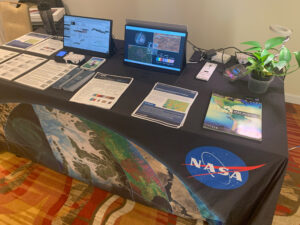Source: Holli Riebeek, NASA’s Goddard Space Flight Center
May 15, 2013 • Have you ever wondered what it might be like to watch the world fly by beneath you from space? That dream is elusive for most of us, but the Landsat Data Continuity Mission offers a vicarious flight with a crisper view than our eyes alone would be capable of if we were in space. That view is now available in a new NASA animation.
After two months of on-orbit testing and calibration, LDCM fired its propulsion system on April 12, 2013, and ascended to its final orbit 438 miles (705 km) above Earth. The animation, made from scenes taken a week later on April 19, allows viewers to fly with the satellite from its final operating orbit.
A 15-minute animation shows 56 Landsat scenes that have been stitched together into a seamless view from Russia to South Africa. The animation was produced at NASA’s Goddard Space Flight Center in Greenbelt, Md.
Orbiting at 16,800 mph (27,000 kph), LDCM made this flight in slightly more than 20 minutes. The animation moves faster, covering 5,665 miles (9,117 kilometers) in nearly 16 minutes. You would have to be moving about 21,930 mph (35,290 kph) to get a similar view — only slightly slower than the Apollo astronauts who entered Earth’s orbit from the moon at 25,000 mph (40,200 kph).
The shorter animation shows a few highlights. Starting in the north, irregular brown fields indicative of a long history of agriculture line the ice-bound Volga River in central Russia. The ice and patches of slightly brown snow reveal a landscape still in winter’s grip. Moving southwest, the snow and ice disappear in the next highlighted segment, and the braided channels of the Volga River run freely. Long airport runways mark the location of the city of Akhtubinsk on the northeast side of the river.
The next highlighted segment transitions from green agriculture near Iraq’s Mosul Dam Lake on the Tigris River to pale desert around the startling blue Lake Qadisiyah behind Haditha Dam on the Euphrates River. Both regions are part of the Fertile Crescent where agriculture was born, and the rivers still support agriculture today even in the desert. Circular fields line the Euphrates River, the pivot irrigated crops incongruous with the surrounding desert.
The next sign of life in the desert is the city of Medina, Saudi Arabia, which radiates out in circles from its central white mosque complex. The animation passes over Jeddah before crossing the Red Sea and into Africa.
Clouds begin to dot the scene over Kenya and Uganda in East Africa in the next segment. Mount Elgon with its broad circular base is a notable landmark on the left side of the scene. Paler green and tan grasslands encroach on dark green forest growing on the sides of the 14,177-foot-high (4,321-meter) ancient volcano. The satellite then crosses over the eastern shore of Africa’s largest lake, Lake Victoria. The shallow water is clouded with tan sediment and green plant growth.
The final highlighted region features the Great Dyke, which runs from northern to central Zimbabwe. This 2.5 billion-year-old formation is an intrusion of igneous rock that pushed into the older rocks that form the core of the African continent. The Great Dyke is rich in minerals and supports an active mining industry.
The instruments on the Landsat Data Continuity Mission collect data in strips, called paths, as shown in the animation. The strips are divided into smaller chunks or scenes for cataloguing and storage at the U.S. Geological Survey Earth Resources and Observation Science Center in Sioux Falls, S.D. The beginning, end and center of the scenes are predetermined to correspond to the scenes collected by Landsat 4, Landsat 5 and Landsat 7, and are catalogued by the path-row system called the Second World-wide Reference System.
A joint U.S. Geological Survey and NASA mission, LDCM launched on Feb. 11, 2013, and is still in its onboard calibration and checkout phase. The images shown here are considered test data. Once LDCM completes its check-out phase in late May, the satellite will be handed over to the USGS and renamed Landsat 8. After this point, the satellite will be considered operational and data will be available from USGS at no cost over the Internet.
To view the video, please visit:
To view the video, please visit:
+ NASA.gov
+ Scientific Visualization Studio
To explore the scene at your own pace, please visit:
+ Earth Observatory






